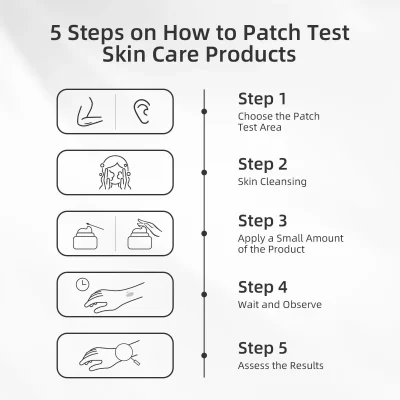How Does Benzoyl Peroxide Work for Acne?
Acne is one of the most common skin conditions, affecting individuals of all ages and skin types. It can lead to physical discomfort and emotional distress, often impacting self-esteem. With a multitude of treatment options available, benzoyl peroxide has emerged as one of the most effective solutions for combating acne. This powerful ingredient is known for its ability to target multiple causes of acne, including bacteria, excess oil and dead skin cells. Understanding how benzoyl peroxide works, along with its benefits and potential side effects, is crucial for anyone considering it as part of their skincare regimen.
What is Benzoyl Peroxide?

Benzoyl peroxide is a potent topical medication commonly used to treat acne. Its effectiveness stems from its unique chemical structure, which allows it to penetrate the skin and target the root causes of acne. Numerous clinical studies have demonstrated its efficacy in reducing acne lesions and improving overall skin clarity, making it a trusted choice among dermatologists
It is available in various formulations, including:
Typically, benzoyl peroxide comes in concentrations ranging from 2.5% to 10%. Lower concentrations, such as 2.5%, are often recommended for individuals with sensitive skin or those who are new to benzoyl peroxide. These formulations can effectively treat mild acne while minimizing potential side effects. On the other hand, higher concentrations, like 5% or 10%, are usually more effective for moderate to severe acne. However, these strengths may also increase the likelihood of skin irritation, so it’s essential to assess your skin’s tolerance when choosing a product.
The Science Behind Benzoyl Peroxide
Understanding the science behind benzoyl peroxide can help understand its effectiveness in treating acne. Benzoyl peroxide works through several mechanisms:
- First, it penetrates the outer layer of skin and targets the sebaceous glands, where acne bacteria thrive. By releasing oxygen into the pores, benzoyl peroxide creates an inhospitable environment for Propionibacterium acnes, the bacteria primarily responsible for acne formation. This antibacterial action significantly reduces the number of bacteria present on the skin.
- Second, benzoyl peroxide promotes exfoliation, helping to shed dead skin cells that can clog pores. This is crucial because clogged pores often lead to the formation of acne lesions. By preventing these blockages, benzoyl peroxide helps maintain clearer skin.
- Lastly, benzoyl peroxide has anti-inflammatory properties. By reducing redness and swelling, it not only helps clear existing breakouts but also diminishes the appearance of new ones.
This multifaceted approach makes benzoyl peroxide a comprehensive treatment option for anyone struggling with acne.
Curious about what might be triggering your breakouts? Check out our article “Why Is My Skin Breaking Out: 10 Causes of Acne“ to uncover the common culprits and learn how to address them for healthier, clearer skin!
Benzoyl Peroxide Benefits
Benzoyl peroxide offers several advantages for those struggling with acne. Its effectiveness stems from its ability to target multiple contributing factors of acne, making it suitable for various skin types. So, is benzoyl peroxide good for acne? The answer is a resounding yes. Some notable benefits include:
- Fast-acting results: Many users report visible improvements in their acne within days of starting treatment. This quick action makes benzoyl peroxide a popular choice for those looking for immediate results.
- Broad spectrum of effectiveness: Benzoyl peroxide works well for different types of acne, including mild, moderate and severe cases. Whether you’re dealing with blackheads, whiteheads, or cystic acne, benzoyl peroxide can help.
- Oil reduction: This treatment effectively reduces excess oil production, which is a significant contributor to acne. By controlling oil levels, benzoyl peroxide helps maintain a clearer complexion.
- Prevention of future breakouts: Regular use can help prevent new acne from forming by keeping pores clear and minimizing bacteria growth.
- Compatibility with other treatments: Benzoyl peroxide can be effectively combined with other acne treatments, such as topical retinoids and salicylic acid, enhancing its overall effectiveness.

How to Use Benzoyl Peroxide Safely
 Using benzoyl peroxide correctly is essential for maximizing its benefits while minimizing side effects.
Using benzoyl peroxide correctly is essential for maximizing its benefits while minimizing side effects.
- To begin, cleanse your face with a gentle cleanser to remove dirt and oil.
- After patting your skin dry, apply a thin layer of benzoyl peroxide to the affected areas, starting with a small amount to gauge your skin’s reaction.
- Initially, use it once daily, gradually increasing to twice daily if your skin tolerates it well.
- It’s also crucial to follow up with a non-comedogenic moisturizer to combat dryness.
Best practices include performing a patch test before widespread application, which helps identify any potential allergic reactions. Avoid mixing benzoyl peroxide with other harsh skincare products at first to prevent irritation. It’s important to be patient, as results may take several weeks to manifest; consistent application is key to achieving clearer skin.
Benzoyl Peroxide: Side Effects and Precautions
While benzoyl peroxide is generally safe, some users may experience side effects, such as dryness, peeling and redness. These effects are often due to its potent nature and the skin’s adjustment to the treatment. To minimize these side effects, starting with a lower concentration is advisable.
Benzoyl Peroxide Allergic Reaction
In rare cases, individuals may have an allergy to benzoyl peroxide. Symptoms can include:
- severe itching
- swelling
- appearance of hives or a rash
If you experience any of these symptoms, it’s crucial to discontinue use immediately and consult a healthcare professional. Even if you don’t experience a full-blown allergic reaction, some people may have heightened sensitivity, resulting in redness or irritation. Always listen to your skin and adjust usage accordingly.
Combining Benzoyl Peroxide with Other Acne Treatments
Benzoyl peroxide can be effectively combined with other acne treatments to enhance its overall efficacy.
Salicylic acid. Both ingredients can work together to reduce acne lesions. Salicylic acid exfoliates and helps unclog pores, while benzoyl peroxide targets the bacteria causing breakouts. However, it’s wise to introduce them gradually to monitor skin tolerance.
Retinol or tretinoin. Combined with those, benzoyl peroxide can provide powerful results. Benzoyl peroxide can be applied in the morning, while retinoids can be used at night, helping to minimize the risk of irritation. This approach can effectively combat existing breakouts and prevent future ones.
Niacinamide. Furthermore, benzoyl peroxide pairs well with niacinamide, which is known for its soothing properties. Layering these two treatments can reduce redness and inflammation while effectively targeting acne.
Looking for more ways to keep your skin clear? Check out our expert tips on How to avoid acne breakouts and take control of your skin’s health today!
Benzoyl peroxide is a potent ally in the battle against acne, especially for those dealing with cystic acne and stubborn pimples. Its multifaceted approach to treating acne makes it a go-to treatment for many. However, it’s essential to use it correctly to maximize its benefits while minimizing side effects.
If you’re looking for reliable acne treatments, check out Ajantastore’s offerings. Products like Perobar Soap and Peroduo Gel are excellent choices that incorporate benzoyl peroxide for effective acne management. Plus, we offer fast delivery across Australia and worldwide, ensuring you receive your skincare essentials right when you need them. Start your journey to clearer skin today!
FAQs
In this section, we address common questions about benzoyl peroxide to further assist you in your acne treatment journey. If you’re new to benzoyl peroxide or considering adding it to your routine, these FAQs can provide valuable insights and help you navigate your skincare choices.
1. Does benzoyl peroxide cause purging?
Yes, benzoyl peroxide can cause purging, especially when you first start using it. This occurs because the treatment accelerates the turnover of skin cells, which can lead to a temporary increase in breakouts as clogged pores are brought to the surface. While it can be concerning, purging typically subsides within a few weeks as your skin adjusts to the treatment.
2. How to use benzoyl peroxide gel?
To use benzoyl peroxide gel effectively, start by cleansing your face with a gentle cleanser and patting it dry. Apply a thin layer of the gel directly to the affected areas, usually once daily at first, and gradually increase to twice daily if your skin tolerates it well. It’s essential to monitor your skin for any signs of irritation and adjust usage accordingly.
3. Are benzoyl peroxide safe during pregnancy?
Benzoyl peroxide is often considered safe during pregnancy, but it’s essential to consult your healthcare provider before starting any new treatment. While topical use is generally lower risk, it’s always better to err on the side of caution and ensure that any skincare regimen is safe for both you and your baby. Your doctor can provide personalized recommendations based on your skin type and condition.
4. Does benzoyl peroxide bleach skin?
Yes, benzoyl peroxide can bleach fabrics, hair, and even skin in some cases. While it typically doesn’t lighten skin tone, it can cause discoloration on clothing or towels, so be cautious during application. To minimize any risk of discoloration, apply it carefully and wash your hands after use.
5. Can benzoyl peroxide remove acne marks?
Benzoyl peroxide primarily targets active acne rather than addressing existing marks or scars. However, consistent use can improve overall skin texture and prevent new blemishes, which may help reduce the appearance of post-acne marks over time. For treating scars specifically, you might want to consider additional treatments, such as vitamin C serums or professional procedures.
6. Can I use benzoyl peroxide with salicylic acid?
Yes, you can use benzoyl peroxide with salicylic acid, but it’s advisable to introduce them gradually. Both ingredients can work synergistically to treat acne—benzoyl peroxide targets bacteria while salicylic acid helps to exfoliate and unclog pores. Start with one product at a time to monitor your skin’s reaction and adjust as needed to avoid irritation.
7. Can benzoyl peroxide burn skin?
Excessive use of benzoyl peroxide can lead to skin irritation, redness, or a burning sensation, especially if applied too frequently or in high concentrations. To avoid this, follow usage instructions carefully and start with a lower concentration to see how your skin reacts. If you experience severe irritation, reduce the frequency of use or consult a dermatologist for advice.
8. How long should I use benzoyl peroxide?
The duration for using benzoyl peroxide varies depending on individual skin types and acne severity. It is generally recommended to use it consistently until your skin clears up and then continue for a maintenance period to prevent future breakouts. Consult a dermatologist for personalized advice tailored to your specific needs and skin condition.
9. Can you use benzoyl peroxide with retinol?
Yes, you can use benzoyl peroxide with retinol, but it’s best to apply them at different times of the day. For example, use benzoyl peroxide in the morning and retinol at night to reduce the risk of irritation. Both treatments can effectively manage acne and improve skin texture, but spacing them out helps minimize potential side effects.
10. Does benzoyl peroxide help with acne scars?
Benzoyl peroxide is more effective at treating active acne rather than directly reducing acne scars. However, by preventing new breakouts and improving overall skin clarity, it can indirectly help reduce the appearance of scars over time. For specific scar treatment, consider complementary products or treatments focused on skin regeneration.
11. Can you use benzoyl peroxide with tretinoin?
Yes, benzoyl peroxide can be used with tretinoin, but it’s advisable to apply them at different times of day to minimize irritation. For instance, benzoyl peroxide can be used in the morning and tretinoin at night. Both treatments are effective for acne, but using them separately helps balance their potent effects on the skin.







